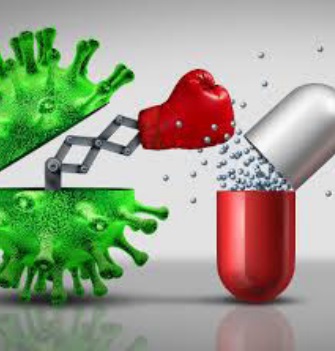 Animals also factor in
Animals also factor in
It is not only humans who use antibiotics. While in some cases administering these drugs to animals is fully justified, recent studies have pointed out a problem when it comes to adding antibiotics to the food of farm animals destined for human consumption.
According to one recent study, “Of all antibiotics sold in the [U.S.], approximately 80% are sold for use in animal agriculture.”
Farmers have resorted to such high rates of antibiotic use in animals to boost growth rates and prevent infections, which are more common among livestock due to ways that producers handle these animals for breeding or as a source of meat.
New research covered on MNT has found that antibiotic resistance is now on the rise in farm animals, too — and the rates are increasing fast.
This situation, some investigators believe, also contributes to the global antibiotic resistance crisis that affects humans.
“We need to better understand how antibiotic use in both humans and animals is related to growing antibiotic resistance — the concept is One Health, where the health of humans, animals, and plants [is] all linked and interdependent,” said Dr. Jesse Jacob.
What are the ways forward?
In the face of this growing threat, policymakers have been pushing for a more careful use of antibiotics in general, while researchers have been searching for treatments that could effectively fight antibiotic resistant bacteria.
“More and more studies suggest ‘shorter is better,’ in terms of how long to treat common infections, but we need more evidence for many of the more complicated infections,” Dr. Jacob told us.
“We need research to find new drugs but can’t rely on a pipeline of new drugs alone to solve this problem, since resistance eventually happens to all drugs.”
Dr. Jacob also pointed to the need for better ways of determining which infections require antibiotics and when it is safe to start and stop this type of treatment.
“We also need to better understand nonantibiotic approaches to treat infections, including bacteriophages, vaccines, and antibodies,” he added.
The team at Emory University has been working hard to find a way to use existing antibiotics more effectively in order to fight off superbugs. The research — to which Dr. Jacob contributed — has shown that it may be possible to fight certain drug resistant bacteria using specific antibiotic combinations.
Another recent study, from the University of California, Los Angeles, suggests that instead of using combinations of one or two antibiotics, as doctors typically do, healthcare professionals may want to use combinations of four or even five such drugs.
Study co-author Pamela Yeh, Ph.D., argues that combinations of multiple antibiotics “will work much better” than current strategies, when it comes to fighting superbugs.
New drugs vs. a more natural approach
Other researchers are on the lookout for new drugs, following a World Health Organization (WHO) report from 2017 that signaled a “serious lack of new antibiotics.”
For example, a team of researchers from the University of Sheffield and the Rutherford Appleton Laboratory, in Didcot — both in the United Kingdom — started developing a new compound earlier this year that they hope will be able to effectively target bacteria, particularly strains of Escherichia coli, that are resistant to multiple drugs.
Other investigators are thinking further outside the box, working to harness the potential of bacteriophages, or bacteria-eating viruses. This is the case of a team from the University of Pittsburgh, in Pennsylvania, and the Howard Hughes Medical Institute, in Chevy Chase, MD.
These researchers report that they were able to successfully treat a severe liver infection in a 15-year-old using bacteriophages that ate the specific bacteria that had been causing serious harm.
Some researchers have turned their attention to probiotics, fighting bacteria with other bacteria.
Last year, specialists from the National Institute of Allergy and Infectious Diseases used Bacillus, a type of probiotic bacteria, to fight one of the most dangerous bacterial strains on the block: methicillin resistant Staphylococcus aureus, better known as MRSA. So far, their experiments in mouse models have yielded promising results.
And various scientists are looking for natural means of fighting superbugs. They suspect that compounds from plant-based sources could be just as, if not more, effective as antibiotics.
So far, researchers have cited green tea, cranberries, Persian shallots, and turmeric as potential sources of effective alternatives to antibiotics.
What we can do for now
For the time being, however, many specialists advise that the focus be on preventing infections from occurring. This, however, is more easily said than done.
The new report from the CDC lists antibiotic resistant Acinetobacter, Candida auris, C. difficile, and Enterobacteriaceae as some of the most urgent threats to health, according to recent data. The catch? All of these bacteria infect people who have recently received medical attention and who, usually, are still in the hospital.
“Some of these bacteria are carried by patients into the hospital, while others are acquired, in part due to otherwise lifesaving interventions, including antibiotic treatments and [other interventions involving] medical devices like intravenous catheters and mechanical ventilators,” Dr. Jacob explained to MNT.
What, then, should doctors do? According to Dr. Jacob, “Healthcare professionals can prevent infections by cleaning their hands and following infection prevention practices, using antibiotics appropriately (only when needed, for the minimum effective duration), vaccinating patients, and communicating between facilities to ensure awareness.”
“Educating patients and families about these approaches is key,” he added.
Regardless of how much care doctors take, however, dangerous bacteria may still prevail. A study from 2018 showed that many bacteria are becoming resistant to the alcohol-based disinfectants used in healthcare facilities.
And newer research, worryingly, has found that C. difficile appears to be resilient in the face of all hospital disinfectants.
Still, while we are faced with a serious threat, specialists maintain that prevention is possible — as long as individuals also do what they can to safeguard their own health. And the best way to do this is by listening to our physicians.
“Use antibiotics only when needed, especially not in ‘just in case’ scenarios,” emphasized Dr. Jacob.
“Discuss the need for antibiotics with your provider. Clean your hands. Get appropriate vaccinations, which save lives and can prevent antibiotic resistant infections,” he advised our readers.
****
Source: Medical News Today
 The Independent Uganda: You get the Truth we Pay the Price
The Independent Uganda: You get the Truth we Pay the Price


